Introduction to Chest Dumbbell Workouts
Regardless of your primary fitness goals, you want to develop your chest. After all, why wouldn’t you? Building it up makes your entire upper body look and perform better. You appear muscular, stronger, and you get to bench press more weight. There is no downside here, and the best part is dumbbell chest workouts can be incredibly effective.
Key points about training with dumbbells:
- Dumbbells allow you to train one side at a time, which adds an element of instability and forces your core to work harder. Plus, by training one side at a time, you develop both pecs equally, preventing muscle and strength imbalances.
- Dumbbells allow you to train with an extended range of motion and better activate your pecs. For example, imagine that you’re bench pressing a pair of dumbbells. You can lower them until you feel a significant stretch in your chest. Then, you can also bring them in as you press them up, which activates your pecs even more. Aside from having your chest assist your tricep in bringing the weight up, it also works hard to adduct your arms (bring them toward the midline of your body).
- Dumbbells are fantastic because their overloading potential is excellent. You can start with weights that feel comfortable and gradually work up over the years until you can press 70, 80, even 100-pound dumbbells.
- You can pick from many fantastic exercises to vary the angle, manipulate the range of motion, and cause different types of stress on your chest.

Hevy – Workout Tracker







Hevy – Workout Tracker
Create your own dumbbell chest workout with Hevy, and track your progress – for free
So, without further ado, let’s dig into the exercises and routines.
7 Chest Dumbbell Exercises for Everyone
Exercise 1: Flat Dumbbell Bench Press
The flat dumbbell press is a fantastic exercise for training the mid and lower portions of the chest.


Muscle groups: Chest, Triceps, Shoulders, Serratus Anterior, and Abs
Equipment: Flat Bench and Pair of Dumbbells
Step by Step Instructions:
- Grab a pair of dumbbells, sit on a gym bench and place the weights on top of your thighs.
- Take a breath and rock your body back as you thrust both dumbbells. As you lie down, the dumbbells should be over your torso.
- With your arms straight and palms facing forward, bring the dumbbells together and position them over your chest.
- Plant your feet into the floor, bring your shoulders back, and breathe.
- Lower both dumbbells to your sides until you feel a stretch in your chest.
- Press up and in until your elbows are straight. Exhale near the top.
Exercise 2: Incline Dumbbell Press
The incline dumbbell press is fantastic because your torso position allows you to emphasize the upper portion of your chest (1).
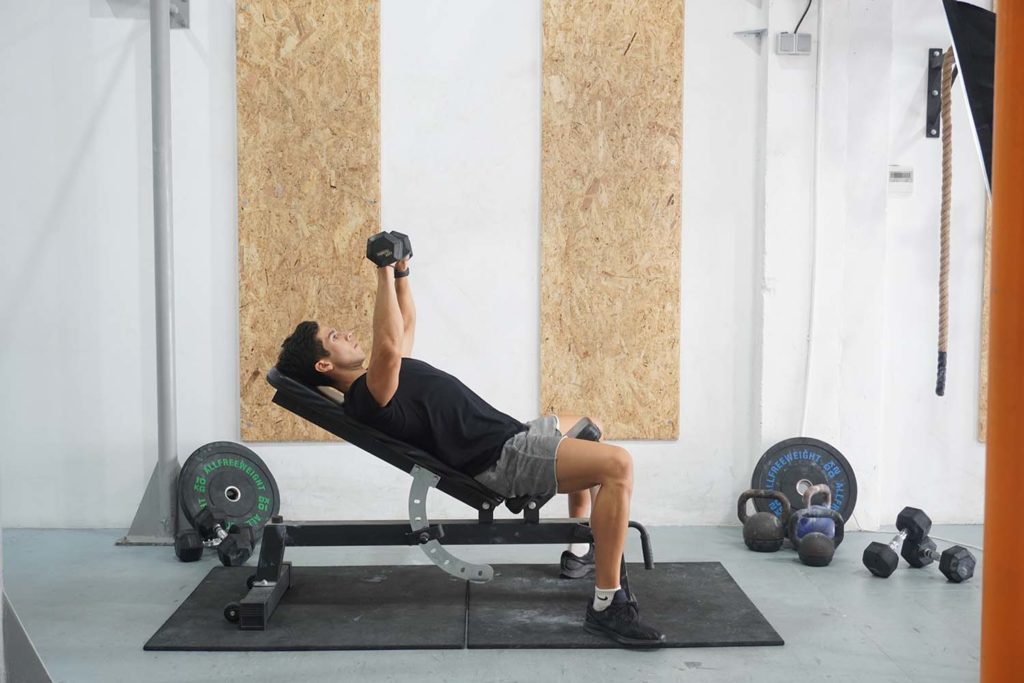

Muscle groups: Chest, Triceps, Shoulders, Serratus Anterior, and Abs
Equipment: Adjustable Bench and Pair of Dumbbells
Step by Step Instructions:
- Set the bench at an incline of around 45 degrees.
- Grab a pair of dumbbells and sit down, resting the weights on top of your thighs.
- Carefully lie back as you keep the dumbbells close to your torso.
- Raise the weights straight up and over your chest.
- Plant your feet firmly into the floor, bring your shoulders back, and breathe.
- Lower both dumbbells to your sides until you feel a stretch in the upper portion of your chest.
- Press both dumbbells up and in until your elbows are straight. You can tap the dumbbells lightly together at the top.
- Exhale and repeat.
Exercise 3: Incline Dumbbell Fly
The incline dumbbell fly is excellent because it primarily isolates your upper chest and serves as a great movement to build up extra training volume without placing much stress on your joints.
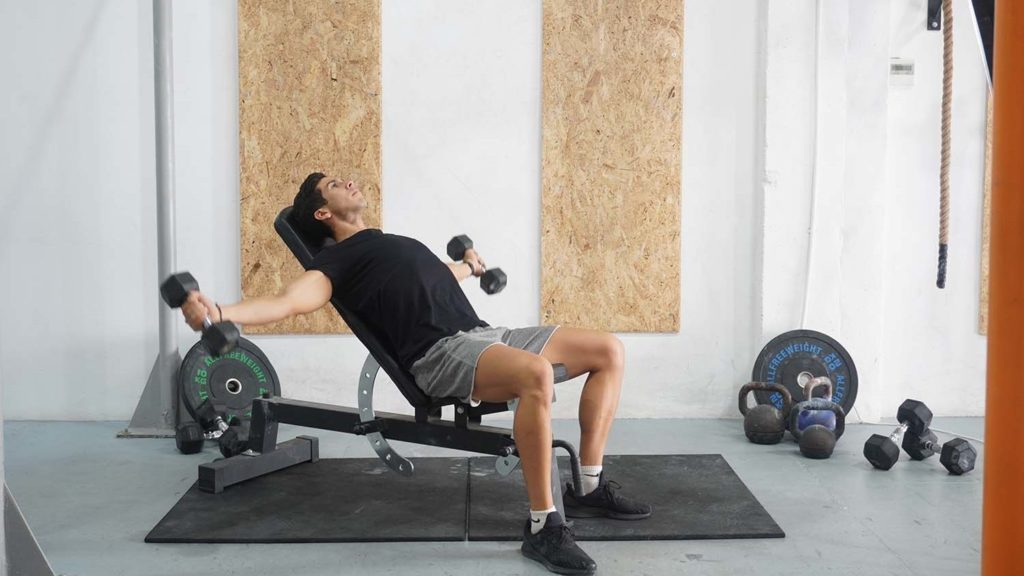

Muscle groups: Chest, Shoulders, Biceps, and Serratus Anterior
Equipment: Adjustable Bench and Pair of Dumbbells
Step by Step Instructions:
- Set the bench at an incline of 30 to 45 degrees, grab a pair of dumbbells, and sit down. Rest the dumbbells on top of your thighs.
- Lie back as you simultaneously extend your elbows and raise the dumbbells over your chest.
- Bend your elbows slightly and keep them that way for the entire set.
- Bring your shoulders back, engage your abs, and take a breath.
- Simultaneously lower both dumbbells to your sides until you feel a stretch in your chest and your elbows are at torso level.
- Bring your arms in, tapping the dumbbells lightly as they come together, and exhale.
Exercise 4: Decline Dumbbell Bench Press
The decline press is an excellent addition to any chest workout because it emphasizes the lower portion of the muscle group and achieves more balanced development (2).
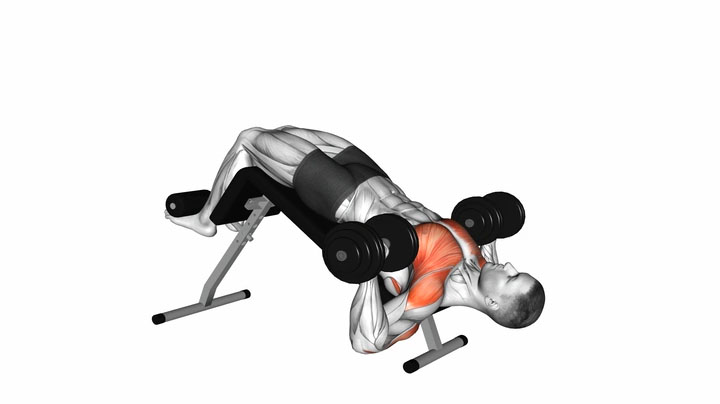
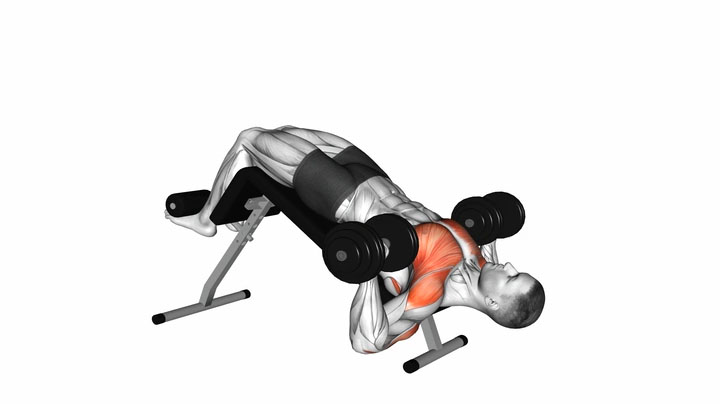
Muscle groups: Chest, Shoulders, Triceps, Serratus Anterior, and Abs
Equipment: Decline Bench and Pair of Dumbbells
Step by Step Instructions:
- Set the bench at a decline of 15 to 30 degrees. It’s okay to experiment here and find what works best.
- With a dumbbell in each hand, get on the bench and secure your feet.
- Carefully lie back while keeping the dumbbells close to your abdominal area.
- Once you’ve laid down, raise both dumbbells over your chest and straighten your elbows.
- Bring your shoulders as far back as you can and take a breath.
- Lower both dumbbells until your elbows are at torso level.
- Press the weights up and in, tapping them lightly if you wish.
- Exhale and repeat.
Note: As you start working with heavier dumbbells, it would be a good idea to have someone hand you one of the dumbbells. Having a spotter will make it easier and safer for you to set up for each set.
Exercise 5: Flat Dumbbell Chest Fly
The flat fly is a great isolation movement that emphasizes your chest’s middle and lower portion (3).
Muscle groups: Chest, Biceps, Shoulders, and Serratus Anterior
Equipment: Bench and Pair of Dumbbells
Step by Step Instructions:
- Grab a pair of light dumbbells and sit on a gym bench.
- Lie back as you keep your elbows bent and dumbbells close to your chest.
- Once you’ve laid back, straighten your elbows and raise the dumbbells over your chest. Have the weights close together.
- Bring your shoulders back, take a breath, and bend your elbows slightly.
- Lower the dumbbells to your sides until you feel a stretch in your chest and your elbows are at torso level.
- Raise both dumbbells, bringing them together at the top.
- Exhale and repeat.
Exercise 6: Dumbbell Pullover
The dumbbell pullover is slightly different from your traditional chest exercises but every bit as compelling. Pullovers are fantastic because the overloading potential is excellent, and you get to stretch your chest well as the dumbbell travels back.


Muscle groups: Chest, Shoulders, Biceps, Triceps, Serratus Anterior, Lats, and Abs
Equipment: Bench and Dumbbell
Step by Step Instructions:
- Grab a dumbbell and sit on a flat gym bench.
- Raise the dumbbell to your chest and position it vertically, with one side facing the ceiling.
- Grab the underside of the top part of the dumbbell with your palms flat and facing the ceiling.
- Lie back while making sure to keep a firm grasp of the dumbbell.
- As you’ve laid back, bring the weight over your chest, straighten your elbows, and make sure your palms face the ceiling.
- Bring your shoulders back and take a breath.
- Extend the dumbbell back and behind your head.
- Pull the dumbbell back over your chest, making sure to squeeze your pecs as hard as possible.
- Stop when the dumbbell is over your chest and exhale.
Exercise 7: Dumbbell Floor Press
The floor press is another great exercise because it takes your legs out of the equation and forces your chest to do all the work by moving the weight up.


Muscle groups: Chest, Shoulders, Triceps, Abs, and Serratus Anterior
Equipment: Exercise Mat and Pair of Dumbbells
Step by Step Instructions:
- Grab a pair of dumbbells and sit on an exercise mat.
- Place the dumbbells to your sides in an upright position and grab them while keeping your arms bent and close to your body.
- Thrust the dumbbells up as you lie back on the exercise mat in one motion.
- Carefully raise both dumbbells over your chest as you extend your elbows fully.
- Bring your shoulders back, take a breath, and engage your abs.
- Lower both dumbbells until the back of your upper arms contacts the floor.
- Press both weights up and in, tapping them lightly in the top position.
- Exhale near the top and repeat.
Note: Lower the dumbbells slowly and avoid bouncing your arms off the floor, as this can put too much stress on your wrists and lead to pain.
To create and track your own workout routines try Hevy.







Hevy – Workout Tracker







Hevy – Workout Tracker
Create your own dumbbell chest workout with Hevy, and track your progress – for free
3 Advanced Dumbbell Exercises
Exercise 1: Single-Arm Incline Press
The single-arm incline press is a fantastic movement for training one side at a time and reinforcing core stability.
Muscle groups: Chest, Triceps, Shoulders, Serratus Anterior, Abs, and Obliques
Equipment: Adjustable Bench and a Dumbbell
Step by Step Instructions:
- Grab a dumbbell and sit at the base of an incline bench. Have the back support at an incline of 30 to 45 degrees.
- Hold the dumbbell firmly and place it on your thigh while supporting it with your free hand.
- In one motion, lie back as you lift the dumbbell over your chest with both arms.
- Bring your shoulders back, engage your abs, and plant your feet on the floor.
- Once you’re comfortable that you can support the dumbbell with one arm, put your supporting arm to your side for balance.
- Take a breath and lower the dumbbell until your elbow is at torso level.
- Press the weight up and in until your elbow is fully extended, and exhale at the top.
- Once finished, grab the dumbbell with your other hand and repeat for the same number of repetitions.
Exercise 2: Single-Arm Floor Press
Given the difficulty of the single-arm floor press, we recommend starting with a lighter dumbbell to get familiar with the unilateral motion and stability requirements.
Muscle groups: Chest, Triceps, Shoulders, Serratus Anterior, Abs, and Obliques
Equipment: Exercise Mat and a Dumbbell
Step by Step Instructions:
- Grab a dumbbell and sit down on an exercise mat.
- Place the dumbbell in an upright position to your right.
- Lift the dumbbell off the floor and keep it close to your body.
- Carefully lay back as you simultaneously extend your elbow and position the dumbbell over your torso.
- Bring your shoulders back, engage your abs, and place your free arm to your side for balance.
- Take a breath and slowly lower the dumbbell until the back of your upper arm is in contact with the floor.
- Press the dumbbell up and in until you feel a more powerful contraction in your chest and your elbow extends fully.
- Exhale at the top and repeat.
- Once finished, bring the dumbbell to your other side, and repeat for the same number of repetitions.
Exercise 3: Reverse-Grip Flat Dumbbell Press
The reverse-grip flat press is a more uncommon exercise that you should approach with caution. Specifically, start with lighter dumbbells to understand the movement better.
Muscle groups: Chest, Shoulders, Triceps, Biceps, Serratus Anterior, and Abs
Equipment: Gym Bench and Pair of Dumbbells
Step by Step Instructions:
- Grab a pair of dumbbells and sit on a gym bench.
- Lift the dumbbells and rest them on top of your thighs.
- Lie back and extend your elbows to position the dumbbells over your chest in one motion.
- As you’re lying with the dumbbells over your chest, rotate your wrists inwards until your palms face back.
- Bring your shoulders back, engage your abs, and take a breath.
- Lower both dumbbells, aiming for them to come just below your chest, then go down until your elbows are at torso level.
- Press both dumbbells up and in until your elbows extend fully. Exhale near the top.
Dumbbell Chest Workout Without a Bench
Chest training isn’t that complicated, and you don’t need that much equipment to make it work. Still, you typically need a dip bar, gym bench, and cable station to have productive workouts. As you can imagine, getting these pieces of equipment for your home workouts isn’t possible, so we need to take a more minimalistic approach.
With that in mind, the below workout is fantastic precisely because you don’t need any special equipment. All three movements require nothing but a pair of dumbbells and a floor for lying down. The only exception is the second movement – the dumbbell push-up – where you need a couple of hexagonal dumbbells that allow you to do the exercise safely.
The third movement is also a significant variation of the classic exercise. But since you’ll be doing the action on the floor, it will naturally limit your range of motion, keep your shoulders in a healthy position, and still provide a good enough stimulus to your chest muscles.
- Floor Press – 3-4 sets of 6 to 20 reps
- Dumbbell Close-Grip Push-Up – 3 sets of 5 to 15 reps
- Floor Chest Fly – 2-3 sets of 12 to 25 reps
Dumbbell Chest Workout at the Gym
Workout 1
Leonardo da Vinci once said, “Simplicity is the ultimate sophistication.” Today, everyone looks for a new, superior, and more effective way to train. We seek better exercises, new ways to organize our workouts, and revolutionary intensity techniques to spark outstanding progress. But, simplicity is often the best approach that allows us to focus our attention on a handful of things, master them, and achieve exceptional results.
This workout is living proof that you don’t need to think about your exercise selection that hard. So long as you understand the anatomy and function of your chest muscles, you can organize your training in a way that emphasizes each region sufficiently. With that in mind, this workout follows the typical reverse pyramid structure, where you begin with heavier weights and gradually progress to lighter ones. The idea is you train as hard as you can while you’re still fresh and lessen the intensity progressively as you get fatigued.
- Flat Dumbbell Bench Press – 3-4 sets of 8 to 10 reps
- Incline Dumbbell Press – 3 sets of 10 to 12 reps
- Decline Dumbbell Press – 3 sets of 10 to 15 reps
Workout 2
If you’re looking for new ways to challenge yourself and shake up your training approach, the below workout is a great option. Unlike the previous two workouts, this one features more advanced movements that will challenge you in new ways and force you to use lighter weights and examine your technique.
The first movement is fantastic because it trains one side at a time, which allows you to focus your efforts better and engage your core to a higher degree. Plus, thanks to the limited range of motion and lack of leg drive, you force your chest muscles to do all the work without ever having your shoulders be in a compromised position. The second movement is also more challenging and emphasizes your upper chest (4). And finally, we have the third chest movement, which isn’t your traditional press or fly. Instead, this pullover exercise emphasizes your chest, lats, and triceps incredibly well when done correctly.
- Single-Arm Dumbbell Floor Press – 3-4 sets of 6 to 10 reps
- Reverse-Grip Bench Press – 3 sets of 8 to 12 reps
- Dumbbell Pullover – 3 sets of 10 to 15 reps
Conclusion
There we have it: the complete list of dumbbell chest workouts you’ll need to train effectively at home and in the gym. Track your chest workout with Hevy and watch your progress.







Hevy – Workout Tracker







Hevy – Workout Tracker
Create your own dumbbell chest workout with Hevy, and track your progress – for free
While many people look for new and fancy ways to train, hoping to make better progress, the truth often lies in the basics. Dumbbells are straightforward, versatile, and incredibly effective. We can use them for various exercises, their overloading potential is impressive, and the range of motion is also great. Plus, we get to emphasize one side of the body at a time, which means dumbbells allow us to focus better. We form a better mind-muscle connection and prevent side-to-side muscle imbalances from developing.
Here is a quick recap of dumbbell chest training:
- You can pick from various fantastic exercises
- You can do these workouts at a gym or at home – whichever you prefer
- We can use one dumbbell at a time to promote core stability and emphasize both sides of the body better
- Dumbbells are great for all three movement patterns that develop the chest: the press, fly, and pullover
- Given the distinct regions of the pectoralis major, using various movements and training the chest through multiple angles is best for optimal development.
Learn more dumbbell workouts:
Legs
Shoulder
Frequently Asked Questions
Why are dumbbells a great piece of equipment for chest exercises?
Dumbbells are fantastic for chest training because:
- Their overloading potential is great
- You can do a variety of practical exercises
- You get to emphasize both sides better and force them to work harder
- They offer a great range of motion
What weight of dumbbells should you start with when beginning weight training?
When wondering what weight to start with – and this applies to every gym exercise you’ll ever do – it’s better to err on the side of less instead of more. Begin with a lighter weight, get familiar with the movement over two or three sessions, and gradually use heavier dumbbells until you find the right weight.
How to avoid getting injured during a dumbbell chest workout?
The three best things you can do to avoid getting injured while training with dumbbells is:
- Warm-up well before each workout and focus on mobilizing your shoulders
- Train with weights you can control at all times
- Focus on doing each exercise with great technique before ever thinking about lifting more weight

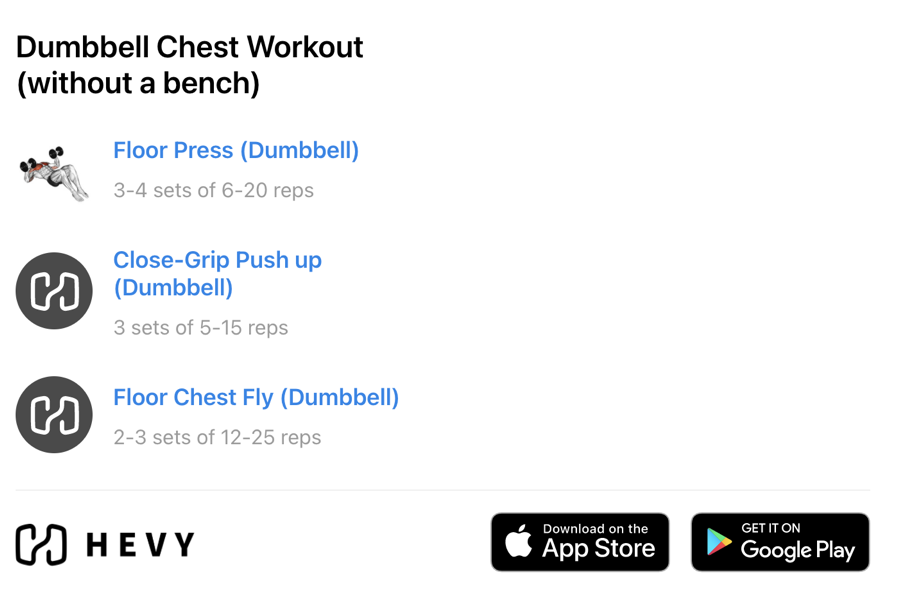












1 thought on “Extraordinary Dumbbell Chest Workouts to Develop Your Pecs”
How long does it take to be able to bench press 100lb dumbbells? I’ve been training for 50 years and can’t do it.